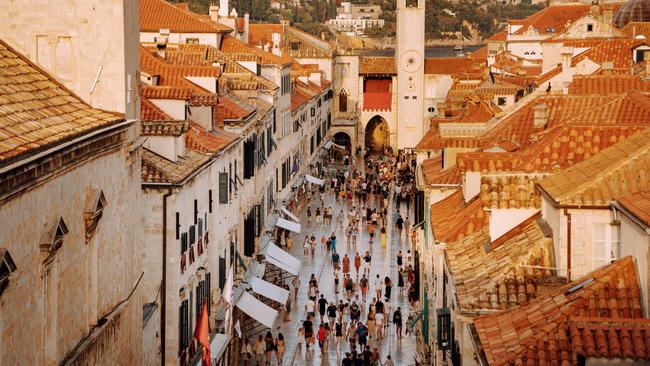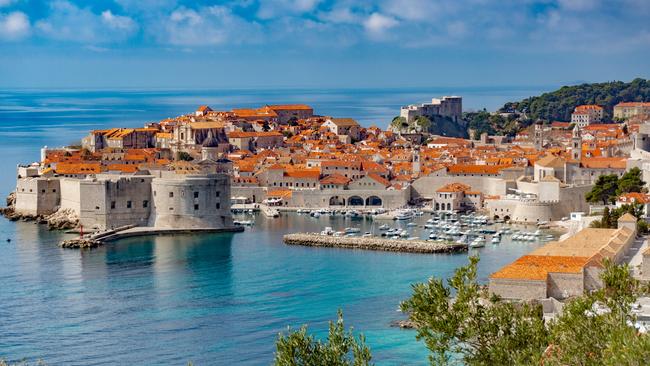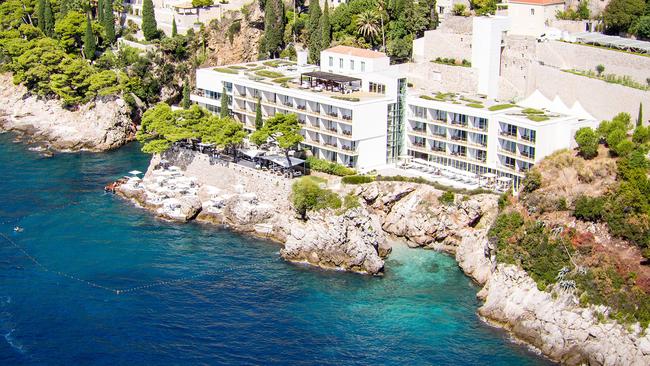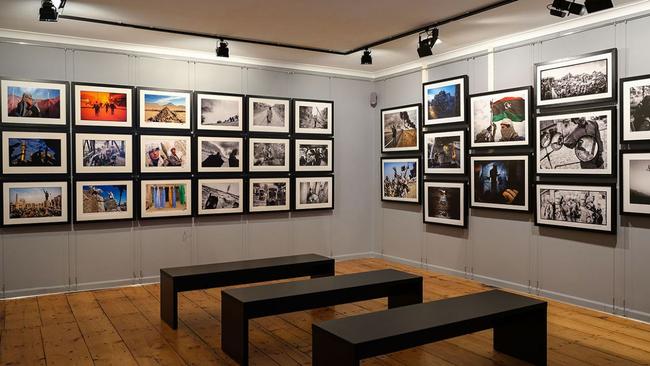Dubrovnik, a city where fantasy and history collide
Brave a ‘walk of shame’ through this ancient European town to uncover its dramatic history and the reason its buildings don’t have balconies.

We are waiting for the Australians,” my guide Ivan Vukovic intones gravely in April as we wander the cobbled laneways of Dubrovnik’s Old Town. He is referring to the fervent hope that Aussie tourists will make a comeback to Croatia this summer after three years of pandemic-induced absence; as the largest visitor nationality after Americans and Britons, we have been sorely missed. If current Instagram and Facebook feeds are any indication, Vukovic needn’t have worried; Aussies have returned with a vengeance. But at the time, his words sounded like an ominous pronouncement from Game of Thrones, especially since almost every town corner features in the series, providing a constant sense of deja vu.
In fact, we are climbing the baroque Jesuit Staircase, which is now generally referred to as the “Shame Steps”. It’s perhaps the most popular of all Game of Thrones sites as the starting point for the Walk of Shame, when the character Cersei Lannister is forced to walk naked through the streets of King’s Landing in Season Five. One lucky cafe that has a window by the staircase has not been shy to capitalise, offering on its menu Shame Mojitos and Shame Burgers to the most devoted enthusiasts.

You can’t really avoid the association, Vukovic explains with a laugh. “I used to try and balance one Game of Thrones walking tour with one history tour. But the movie tours filled up so quickly. Now I do three Game of Thrones tours for each history tour.”
I find Dubrovnik’s past as over-the-top and eccentric as any TV fantasies, and Vukovic gives me a crash course of its life since the 12th century. In its heyday as the Republic of Ragusa, the city operated as an independent maritime state for more than four centuries, from 1385 until Napoleon conquered it in 1808. Although an “aristocratic democracy”, it was one of the most progressive and free corners of Europe, a status it maintained by playing off East and West, using its strategic location to negotiate with both Ottomans and Christians. One of its unlikely claims to fame is that the republic was among the first half-dozen nations to recognise the independent United States, presenting credentials to Benjamin Franklin in Paris in 1783 (Morocco was the first).
While explaining all this, Vukovic tosses out oddball facts. Ringed by mammoth walls, the Old Town measures just 300m by 300m, but it contains 5550 steps. Along the famous main thoroughfare Stradun, paved with pale limestone blocks worn smooth by centuries of foot traffic, he pauses and points up. “Why are there no balconies in Dubrovnik?” he muses. In a devastating 1667 earthquake, they all collapsed, killing and injuring the people below, so balconies are still banned today. Wood-burning kitchens also have to be on the top floor to contain damage from fires.

Like Venice, Dubrovnik’s historic heart is emptying out. From the Middle Ages until the 1980s, about 5000 people lived in the Old Town, but now it is more like 1000, all of whom have to deal with more than a million annual tourists. Apart from the housing casualties to Airbnb, a former women’s convent has just been turned into Croatia’s first Hard Rock Cafe. Even in the off-season, the main street of Stradun can get tight when a cruise ship arrives with 4000 on board. But Vukovic leads me into quieter backstreets such as Ulica Od Rupa and Ulica Svete Marije around the Ethnographic Museum (which, incidentally, was the exterior of Littlefinger’s brothel in Game of Thrones). We pause at a doorway, where a couple, family friends of Vukovic, have turned their downstairs living room into a storefront, selling local spices in glass tubes, delicious olive oil and carob treats for dogs.

Croatia’s Adriatic coast is nothing if not pleasant, with a sun-dappled hedonistic charm that provides an illusion of timelessness. I arrived the day before and am staying in the Hotel Villa Dubrovnik, a 1961 Modernist oasis with nautical white lines that jut over the undulating Adriatic Sea. At night, I walk a dreamy laneway 15 minutes into the city, passing mansions and rocks with ancient carved stone steps leading down to the lime-green, eerily clear waters. And (of course) I have a fine fish meal. “Fish should swim three times,” the restaurant owner declares, “in water, in wine, and in the stomach.”
But the turbulent recent history of Dubrovnik lies just below the surface. As I walk with Vukovic around the titanic city walls, built from the 13th century, we gaze down on the famous ocean of orange tile roofs, apparently intact since the Middle Ages. But he points out that only the faded brown tiles are “pre-war” survivals. “You see all the bright orange ones? That’s where the bombs landed.”

In fact, about 75 per cent of Dubrovnik’s medieval roofs were damaged by shelling in the siege of 1991-92, the low ebb of what Croatians call the Homeland War, as the republic fought for independence from Yugoslavia as part of the long and confusing Balkans conflict. Later, in Stradun, he pauses at a cathedral to point out the shrapnel marks in the stone walls. “Nobody believed it would happen,” he says of the bombing. After all, the Old Town was a European treasure, and one of the first 10 World Heritage sites ever listed, in 1979. What’s more, there was no military presence in the town; it was a purely civilian outpost. He then recounts how four members of his class of 23 primary school students died in the siege.
The next day, I decide to educate myself on the dramatic war that is still within memory. Luckily, Dubrovnik has three quirky new museums to help. For a primer, I start at the most peculiar, the new Red History Museum about life in the former Yugoslavia under Marshall Josip Tito, the Communist strongman who steered a course between the US and USSR from World War II to his death in 1980. Located in a former carbon graphite factory by the port, the museum exudes a wistful air. Few Croatians want to return to the era, but there is a nostalgic fascination with the industrial-style design and textures of the time. With a more open economic system than the rest of the Eastern bloc, Yugoslavia was where young travellers would come from Warsaw and Kiev to buy blue jeans and Western LPs. (There is also a dimly lit section to show the “dark” side of Tito’s authoritarian regime.) Locals donated Yugoslav-made telephones, blenders, TVs, furniture and school books to recreate the distinctive style of domestic life, and there is a locally built car to sit in for photographs.

Perhaps the most entertaining room is an exhibit on Yugoslav night-life in the ’70s and ’80s, when wild-haired rock bands performed at makeshift discos, hotels and floating bars. The museum shop sells colourful travel posters from the era, canvas shoes that are still made in the retro Yugoslav fashion and, mysteriously, gas masks.
In 1991, barely more than a decade after Tito’s death, the patchwork of nations within Yugoslavia began to break apart. There are two museums on the conflicts in Dubrovnik: On a narrow alley in the heart of the Old Town, New Zealand-born photojournalist Wade Goddard, who covered the assorted fronts, has set up War Photo Limited. It has a permanent gallery of powerful images from the various Balkan wars, as well as revolving exhibitions from Africa and, naturally, the Ukraine.

The second museum is in one of the most spectacular settings in the city, in a Napoleonic-era fortress at the top of the Mount Srd. I reach it by a cable car, lapping up the astonishing eagle-eye views of the Old Town, coastline and sparkling Adriatic. It is a surreal contrast to enter the icebox-cold Fort Imperial, where faded photographs are set up in the damp, sometimes dripping chambers alongside military relics recounting the siege of Dubrovnik by largely Serbian forces.
The museum is not particularly well organised, but it is very affecting to see the images while on location: the beloved Stradun bombed out and deserted; smoke billowing down picturesque laneways; the ritzy Imperial Hotel on fire. TV footage shows the first artillery shells being fired at the medieval city walls and virtually bouncing off. Fort Imperial itself was the site of some of the heaviest combat as a handful of Croatian soldiers resisted repeated heavy attacks.
More than 30 years later, there is still a sense of disbelief and betrayal. “We really felt that the rest of the world had abandoned us,” one local official tells me, asking not to be named. “Who could have imagined that a UNESCO World Heritage site would be shelled in the middle of Europe, in this day and age, and nobody would do anything about it?”
But by sunset, such grim images seem very far away. It is a relief to step out of the frigid fortress and wander down to the summit cafe, bathed in Adriatic sunshine.

In the know
Located in the far south of Croatia, Dubrovnik became markedly easier to reach by land at the end of 2022 when it was finally connected to the rest of the country by a Chinese-built bridge. Before then, cars would have to pass through border/immigration controls in Bosnia-Herzegovina, or take a ferry north to Split and Hvar.
The 56-room Villa Dubrovnik, which has a Michelin-recommended restaurant, is a 15-minute stroll from the Old Town. Each room of the 1961 Modernist property has a terrace; from €837 ($1370) a night.
There is no shortage of high-end fish restaurants with a view, but I return to Azur, a casual bistro on a quiet alley in the Old Town with a Croatian-Asian fusion theme. It’s run by born-and-raised resident Darko Perejovic. The meals are light and healthy, the staff friendly and the local wine delicious.
Afterwards, skip the pricey cafes on Stradun and grab a beer at Buzz on a side street; it’s where locals head to wind down after a long day.
The Red History Museum is a short taxi ride out of town at the port; adults €10.
War Photo Limited is in the heart of the Old Town. It aims “to let people see war as it is, raw, venal, frightening, by focusing on how war inflicts injustices on innocents and combatants alike”; adults €10.
It’s possible to hike the steep 4km zigzag path up to the Homeland War Museum, but most people opt for the cable car; €31 including museum entry.






To join the conversation, please log in. Don't have an account? Register
Join the conversation, you are commenting as Logout